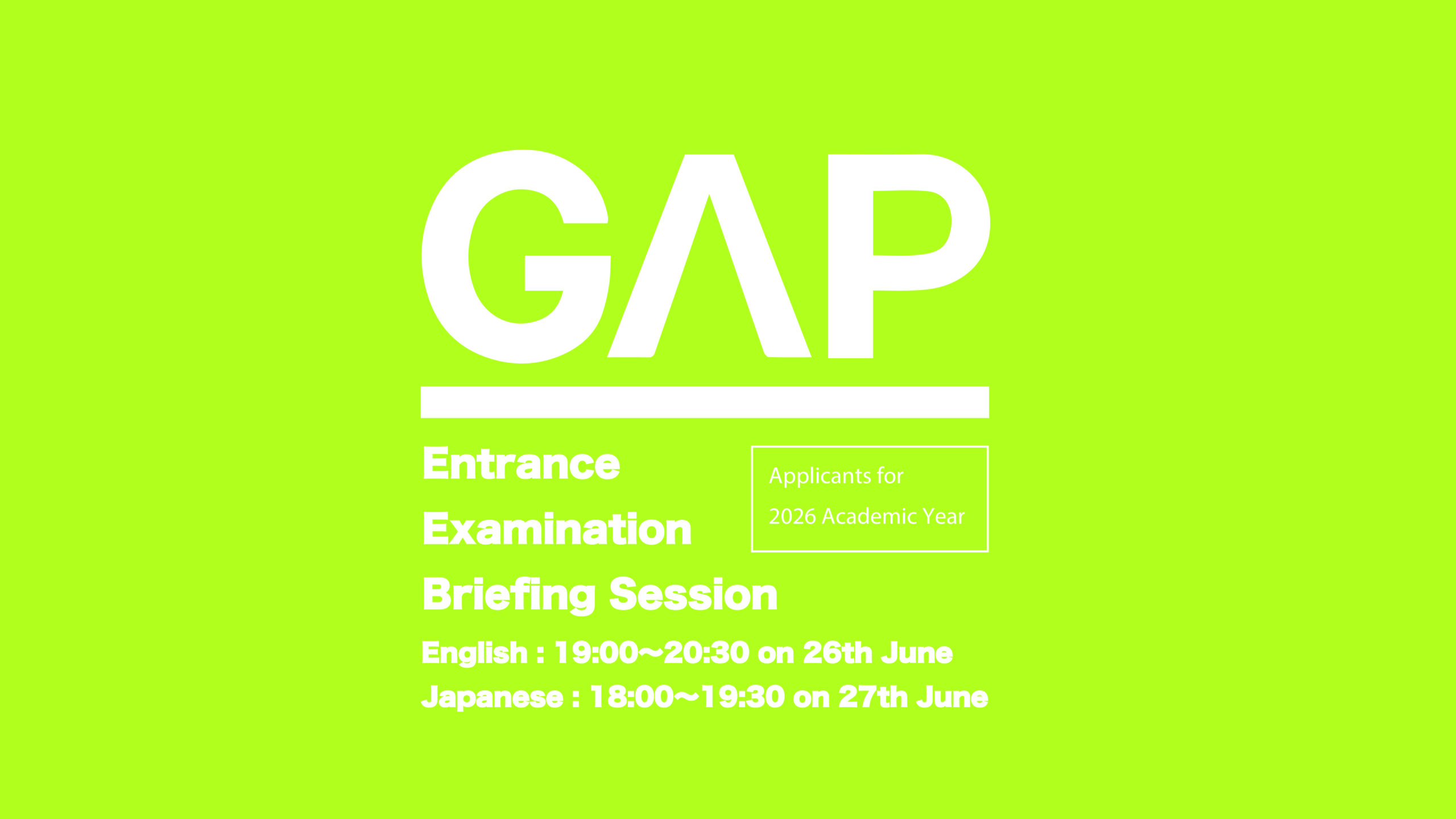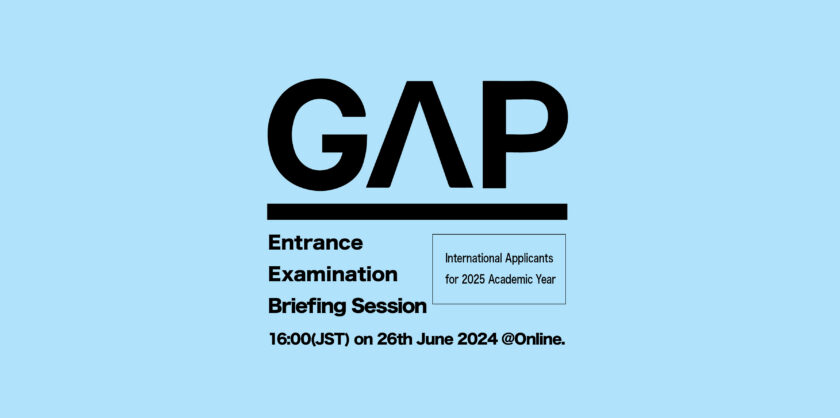The Global Art Practice (GAP) program is seeking applicants who are willing to
【MFA Program】
- formulate ideas, expressions, attitudes and actions toward a new form of art with an understanding of current social conditions and the contemporary cultural landscape.
- initiate diverse changes through art and pursue active inquiry into the global era as participants rather than as bystanders.
- seek their own artistic expression through critical analysis and self-reflection, and break free from restrictive discourses and value systems.
- pursue a globally contextualized art practice that examines and liberates humanity on a horizon of freedom.
- create images (materiality) from the recognition of contemporaneity in encounters with a variety of people and places.
- investigate and thoroughly think how art can be translated and activated for a global audience.
- endeavor to acquire the necessary language, practical skills, and perspective to practice art in a global context.
Requirements for completion of MFA Global Art Practice
Completion of GAP is certified based under Article 9 of the degree regulations at Tokyo University of the Arts.
Obtainable degree is “Master of Fine Arts”.
The conditions required for the examination are as follows.
- Choose and submit one of the three methods: artwork and essay, artwork and thesis, or thesis.
- The thesis and essay can be written in either English or Japanese.
- The thesis must be 20,000 or more characters for Japanese, 12,500 or more words for English (excluding notes and references).
- The abstract for the thesis must be within 2,000 characters in Japanese and 1,250 words in English (submitted both in English and Japanese).
- If you wish to complete the course only with your thesis, please obtain permission from your main advisor by September of the first year of enrollment.
【Doctoral Program】
- pursue their studies self-directed, with a clear objective and with a view to their future practice; having gained the necessary experience outlined in the admissions policy of the GAP MFA program.
- contextualize their local environment and its conditions (e.g. identity, cultural roots) to arrive at their own opinions concerning global trends; and practice art in the international community with an understanding of their own role and standpoint in the world.
- seek new perspectives and values outside boundaries of nationality, belief, and culture, andーthrough their art practiceーpose questions and new ideas to society.
- carve out their own distinctive art practice and realize their ideas as active members of society.
Completion of the Doctoral program in GAP is certified based under Article 9 of the degree regulations at Tokyo University of the Arts. Obtainable degree is “Doctor (Art)” or “Doctor of Philosophy”
東京藝術大学大学院美術研究科グローバルアートプラクティス専攻(GAP専攻)では、下記のような学生を求めています。
【 修士課程 】
- 今日の社会状況や互いの文化的背景を理解しながら、新しい芸術への発想、表現、態度、行動を生みだそうとする人。
- 傍観者ではなく積極的にグローバルな時代を問いかけ、芸術をとおして多様な変化を志向する人。
- 自らを守り拘束する言説や価値観を内破し、客観的に自己を見つめ芸術表現をめざす人。
- 自由な地平から人間の在り方を問うグローバルな芸術実践に意欲のある人。
- 様々な人や場所との出会いを通じて同時代性を認識し、そこから手応えとしてのイメージ(実体)を創り出そうとする人。
- アートを、世界の人に対していかに翻訳し、活用させるかを思考する人。
- グローバルな文脈でのアート活動に必要な言語、技術、視点を積極的に獲得しようと努力する人。
GAPの修了については、東京藝術大学学位規則第9条に基づいて合格が認定される。
取得できる学位は「修士(美術)」Master of Fine Arts である。
審査に必要な条件は以下である。
- 修士作品およびエッセイ、修士作品および修士論文、修士論文、の3つのうち一つの方法を選び提出する
- 修士論文とエッセイの執筆言語は日本語または英語とする
- 修士論文については日本語 20,000字以上、英語12,500 word以上(註や参考文献を除く)とする
- 修士論文提出者はその要旨を日本語2,000字および英語1,250word(バイリンガルで提出)以内で提出すること
- 修士論文のみによって修了を希望する場合は修士1年次の9月までに担当教員の許可を得ること
【 博士課程 】
- 修士課程のアドミッションポリシーで示した芸術実践において経験を積み、自らの方向性を確立し、これからの活動について明確な目標と展望を持って取り組む人。
- ルーツやアイデンディティといった自らを取り巻くローカルな環境とその諸条件に向き合い、相対化した上で、グローバルな世界状況についても自分なりの見解を持ち、国際社会のなかで自らの立ち位置や役割を把握しながら柔軟に芸術活動を実践する人。
- 国、文化圏、信条など様々な既存の境界に捕われない新たな視点や価値観を模索し、創作活動を通じて社会に問いかけや提案を行おうとする人。
- 社会の営みの一部として、独自の具体的な実践の場を自ら切り拓き、実行に移せる人。
東京藝術大学学位規則第9条に基づいて合格を認定する。取得できる学位は「博士(美術)」または「博士(学術)」Doctor of Philosophy である。
Due to the specific features of our curriculum, preparing and planning for your individual support may take time. If an applicant requires special accommodations for examination or enrollment, please consult the Global Art Practice faculty in advance. Applicants with long-term medical conditions such as diabetes, allergies or arthritis, are also encouraged to contact the faculty for preliminary consultations.
Special features of GAP curriculum:
- Collaboration with students from various countries, cultures and backgrounds.
- Programs such as the Unit Program (a joint class program with our overseas partner schools) involving overseas travels, and staying and working in groups for several weeks in Japan and abroad.
- Special programs held during the holidays in the University academic calendar
- (※ Classes may be held during the summer holiday.)
- Technical training in the workshops (woodwork, metalwork, casting, glass, etc).
For preliminary consultation:
gap.exam@ml.geidai.ac.jp (available in English and Japanese)
グローバルアートプラクティス専攻はカリキュラムの特性上、修学上の配慮の準備や計画に時間を要することがあります。障がいのある者等、受験上及び修学上の配慮を必要とする者は、必ず事前に相談をしてください。また、糖尿、アレルギー疾患、関節リウマチなどの慢性疾患等の病気治療・管理の必要がある場合も事前に相談してください。
GAP カリキュラム特性:
- 多国籍、多文化、様々な背景を持つ学生との協働。
- ユニット授業(海外の芸術大学との共同授業)等における、海外への長期渡航、国内外での数週間に渡る集団生活と集団行動。
- 東京藝術大学の学事歴における休業期間中のGAP独自のカリキュラムの実施。(※夏季休業期間中も授業を開催する可能性があります。)
- 工房(木工・金工・鋳造・ガラス等)を使用した実技演習。
事前相談先:
gap.exam@ml.geidai.ac.jp (日本語・英語対応可)
MFA (Period 1)
- Guidance for Prospective Students/Global Art Practice (MFA Program) for International Students(2025 Academic Year)
- 2025年度グローバルアートプラクティス専攻(修士課程)外国人留学生入試学生募集要項 (Guidance in Japanese)
– the day of publishing :28th June, 2024
MFA (Period 2)
- Global Art Practice Entrance Examinations Period 2 screening (MFA Program)
- 2025年度グローバルアートプラクティス専攻修士課程第2期選抜試験学生募集要項
– the day of publishing :16th July, 2024
PhD
- Global Art Practice Entrance Examinations (Doctoral Course)
- 2025年度グローバルアートプラクティス専攻博士後期課程学生募集要項
– the day of publishing :16th July, 2024
Briefing Documents from the past 過去の説明会資料
Please refer to the links below for information for international students:
About scholarships and bursaries
About accommodation
留学生の為の情報は、下記リンク先を参考にしてください。
奨学金について
宿舎について
Please check these frequently-asked questions before sending any enquiries.
1. When is the entrance examination?
The exams for students aiming to enroll in April of the following year are held twice per year.
Summer (application deadline July, carried out in August): International students (master’s)
Winter (application deadline November, carried out in February): General entrance examination (Master’s and Doctorate)
※The general entrance exam carried out in February can be taken by Japanese students or by international students.
※Classes will commence in April 2025. Those without a valid residence status in Japan must obtain a residence status that does not interfere with their graduate studies at the time of enrollment. This application process is expected to take up to three months from the announcement of admission results. For those who need to newly apply for a Certificate of Eligibility (COE) for residence status at our university, we strongly recommend taking this entrance examination for international students.
※Recruitment seasons and contents will change, to a greater or lesser extent, every year. Please refer to our entrance examination website for the application details.
2. When will the Guidance of Prospective Students be published?
Publication of the Summer entrance examination for international students is planned for May (Japanese and English), and publication of the Winter general entrance examination is planned for July.
3. What proportion of enrollment will be international students?
The Global Art Practice major will accept international students as a proportion of no less than 1/3 of its fixed number of 18 students (i.e. 6 students or more).
Past enrollment proportions were as follows:
- 2016 enrollment | 6 international students : 12 Japanese students
- 2017 enrollment | 10 international students : 8 Japanese students
- 2018 enrollment | 8 international students : 9 Japanese students
- 2019 enrollment | 10 international students : 5 Japanese students
- 2020 enrollment | 8 international students : 9 Japanese students
- 2021 enrollment | 11 international students : 7 Japanese students
4. What countries have students come from?
Chile, China, Colombia, Democratic Republic of the Congo, Hong Kong, Iran, Japan, Mexico, Norway, Philippines, Romania, South Korea, Spain, Taiwan, Tailand, UAE, UK , USA, Russia
5. Are there standards for the English-language test?
All applicants of the Global Art Practice course are required to submit certified scores from one of the following examinations by external testing organizations.
For details about the English-language test, please refer to the Tokyo University of the Arts entrance examination website.
Tokyo University of the Arts Admissions > FINE ARTS (Private students) > Graduate Students (Master/Doctor)
No further information about the scores are publicly available.
6. What is the required level of English communication ability?
Every basic lesson will be carried out in English.
Moreover, everyday conversation ability is preferred, so that you will progress through the curriculum while communicating and cooperating with fellow students from a variety of backgrounds.
7. What is the required level of Japanese communication ability?
Every basic lesson will be carried out in English.
However, being able to speak Japanese will make life in Japan and communication with Japanese students and teachers smoother, so we recommend that you study Japanese independently.
8. Will there be instruction or activities outside of the university?
We are planning activities outside of the university that will span multiple weeks, domestically and abroad, such as trips to study antiquities, and a long-term trip abroad in a unit program (collaborative classes with overseas arts universities)
9. Is there time for a part-time job?
There is almost no time for a part-time job alongside the curriculum, because of the variety of courses being held, such as unit program (collaborative programs with overseas arts universities), lectures and workshops by guests invited from overseas, and hands-on skill practice using workshops (woodworking, metalwork, casting, glasswork, etc.). Moreover, there have been cases in the past at Tokyo University of the Arts in which even during days off or holidays, curricula specific to GAP have been carried out.
10. What format should my portfolio be in?
Any portfolio format is acceptable. File format: PDF. Maximum file size: 150 MB. All portfolios must be submitted in PDF format, regardless of the software used to make the portfolios. Please do not set a password to download the file.
11. Where is GAP located?
GAP Department is located in Toride Campus, Ibaraki Prefecture.
以下をご確認の上、本専攻へお問い合わせください。
1)入試はいつありますか?
次年度4月入学生対象の試験を、年に2回実施しています。
夏(7月頃願書〆切 / 8月頃実施):外国人留学生対象(修士)
冬(11月頃願書〆切 / 2月頃実施 ):一般入試(修士・博士)
※2月実施の一般入試では、日本人学生と外国人留学生のどちらも受験することが可能です。
※募集時期・内容は毎年多少変動します。必ず東京藝術大学の入試サイトを確認してください。
※授業は2025年4月より開始します。日本の在留資格を持たない者は、大学院在学に支障のない在留資格を入学手続き時に取得する必要があり、その申請には合格発表から最大3か月程度かかることが想定されます。入学にあたり、新たに本学で在留資格認定証明書交付申請の必要がある者については、この外国人留学生入試を受験することを強く推奨します。
2)入試募集要項はいつ頃掲載されますか?
夏の外国人留学生入試は、5月頃(日・英)に掲載予定、冬の一般入試は、7月頃に掲載を予定しています。
3)留学生はどのくらいの割合で在籍していますか?
グローバルアートプラクティス専攻では、一学年の定員18名の内、3分の1以上(6名以上)の割合で、留学生を受け入れています。
過去の入学生の割合は下記の通りです。
- 2016年度入学生|留学生6名:日本人学生12名
- 2017年度入学生|留学生10名:日本人学生8名
- 2018年度入学生|留学生8名:日本人学生9名
- 2019年度入学生|留学生10名:日本人学生5名
- 2020年度入学生|留学生8名 : 日本人学生9名
- 2021年度入学生|留学生11名 : 日本人学生7名
4)学生の出身国はどこですか?
チリ、中国、コロンビア、コンゴ民主共和国、香港、イラン、日本、メキシコ、ノルウェー、フィリピン、ルーマニア、韓国、スペイン、台湾、アラブ首長国連邦、イギリス、アメリカ、ロシア
5)英語試験のスコアの目安などありますか?
グローバルアートプラクティス専攻では、入学試験の際に、すべての志願者に対し、外部団体が実施する英語の語学能力試験の提出を求めています。
英語試験についての詳細は、東京藝術大学入試サイトを参考にしてください。
東京藝術大学入試情報サイト > 大学院入試 > 美術研究科 > 募集要項
またスコアに関することは、一切公開してません。
6)英語はどのくらい話せる必要がありますか?
授業の基本は全て英語で行われます。
また、様々なバックグラウンドの学生同士がコミュニケーション・協働しながらカリキュラムが進むため、日常会話ができることが望ましいです。
7)日本語はどのくらい話せる必要がありますか?
授業の基本は全て英語で行われます。
しかしながら日本語が話せることで、日本における生活や、日本人学生・教員とのコミュニケーションなどがより円滑にすすみますので、自主的な日本語の勉強をおすすめします。
8)学外での授業や活動はありますか?
ユニット授業(海外の芸術大学との共同授業)等における海外への長期渡航、また古美術研究旅行など、国内外での数週間に渡る学外活動を予定しています。
9)アルバイトをする時間はありますか?
ユニット授業(海外の芸術大学との共同授業)や、海外からの招聘ゲストによる講演会やワークショップ、工房(木工・金工・鋳造・ガラス等)を使用した実技演習など、さまざまな授業を開講する為、カリキュラムと並行してアルバイトができる時間はほとんどありません。
また、東京藝術大学の学事歴における休業期間中にも、GAP独自のカリキュラムを実施する場合があります。
10)ポートフォリオはどのような形式で提出したら良いですか?
ポートフォリオの形式は自由、ファイル形式:PDF 、データ上限:150MBです。作成するプログラムに関わらず、提出の形式はPDFのみです。開封時にパスワードを求める設定を使用しないでください。
11) GAPのキャンパスはどこになりますか
GAP専攻は茨城県、取手校舎になります。


